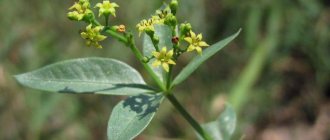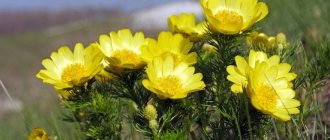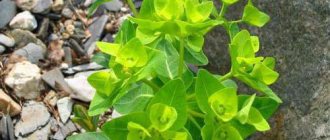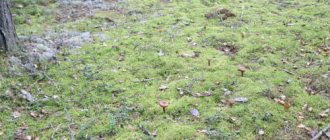The area of the garden or vegetable garden where the navel, which looks like a chamomile, grows, attracts attention with bright white or yellow flowers - they stand out noticeably among other flower crops. In the wild, it is found everywhere in dry meadows, forest edges, clearings, steppes, and along roads. In garden plots and local areas it is cultivated as an ornamental and medicinal plant. Looks great in group plantings, against the backdrop of deciduous perennials, and in compositions with flowering annuals.
Navel - description of species
Each type of navel has its own distinctive features, sometimes not very pronounced. Description of the species will help to get an idea of the culture.
The words “navel” and “navel” are related. The flower got its name because of its peculiarity - at night the outer flowers droop, as if hiding, and the yellow center (the navel) is exposed. In the evening, the basket looks like a convex yellow ball in a white skirt. In common parlance, the flower is sometimes called “navel grass.”
Plant varieties
The Asteraceae family, which includes the navel tincture, has a huge number of species. In nature, there are about 100 varieties of this herbaceous plant. Let's look at just a few of them.
- Mayweed. It grows on the territory of European countries. It can be found especially often in Ukraine and the Caucasus, Belarus, Moldova and the Russian Federation. The plant has medicinal properties and is used for epilepsy. For these purposes, an infusion is prepared: a teaspoon of dried crushed roots is poured with boiling water (200 ml). The product is infused for 3 hours, after which it must be strained and drunk 50-75 ml 3 times a day. Herbal juice is drunk in small doses (a tablespoon 3 times a day) for cancer. Powder from dried roots is used to enhance male potency, poultices are effective for toothaches.
- Dog's belly button. The plant is an annual plant with an unpleasant odor. In its chemical composition it is very similar to the dye's navel. Used as an anthelmintic and diuretic. The plant heals wounds well and has an antispasmodic effect. For flatulence, enemas are made from an infusion of herbs.
- The navel is noble. The plant is used as a remedy for gastrointestinal diseases (flatulence, heaviness in the stomach, spasmodic pain). It eliminates inflammation in the mouth and throat well. The noble navel has white flowers and has bleaching properties, so it is used to make hair dyes.
All these types of plants, despite the very funny name, have useful medicinal properties and help fight numerous diseases.
Dying navel (yellow, yellow-flowered, Antemis tinting)
On a simple reddened branching stem, 0.4-1 m in height, there are alternate bluish-green leaves. The shape of the wrinkled leaf is pinnately dissected; cobwebby hairs are clearly visible on the surface. In the year of planting, only a leaf rosette develops; in biennial plants, flower stalks appear. The roots are multi-headed, strong, and grow strongly.
Flowers with a specific aroma form a single inflorescence-basket (6 cm in diameter), located on a long peduncle. The female marginal flowers are yellow or orange in color, the tubular middle flowers are of the same color. Flowering lasts from June to September. The seeds ripen in July-October.
The entire above-ground part is used for medicinal purposes; the flowers serve as raw materials for producing lemon-yellow paint.
Stinky navel (dog)
The variety belongs to low herbaceous annuals - the height of the bush reaches 30 cm. The thread-like roots are long, tangled, the highly branched stem is bare or covered with hairs. The serrated or solid leaf is narrow (2 mm), with a sharp tip. The flower is a single basket with white marginal flowers and yellow tubular ones. Flowers are produced all summer. The seeds ripen from late July to mid-August. The plant received the name “stinker” because of the characteristic, not very pleasant, smell of the above-ground part. Used in folk medicine.
Mayweed
Field navel is classified as an annual herbaceous plant with numerous erect, most often branching stems (height from 15 to 50 cm), the surface of which is covered with appressed hairs. The oblong, slightly pubescent leaf is dissected into narrow, sharp lobes. The inflorescence is a single basket (2-3 cm in diameter) on a thickened stalk. The color of the marginal false-lingulate flowers is white, the middle tubular flowers are yellow. Flowering continues all summer.
Field navel is an indicator of soil acidification and clogs the plantings of many crops. It is characterized by superficial germination. Seeds remain viable for 15 years.
Russian navel
The grayish felt annual grows from 10 to 40 cm in height. On the stems, which are strongly branched from the very base, there are oblong-shaped, dissected into triangular sharp lobes, bluish-green leaves. The flower is a basket (diameter 2 cm) on a thin long stalk, the color of the marginal flowers is white, the tubular flowers in the middle are yellow. Blooms from early summer to September. Seed ripening begins in July.
Navel nobilis (Roman chamomile)
A distinctive feature of the species is that it is a low (up to 30 cm) perennial that is resistant to cold. The root system is creeping, branched, and lies deep. The cylindrical straight stems are highly branched, the surface is covered with hairs. Sessile leaves are dissected, elongated, with a sharp tip. The basket (0.6-1.2 cm in diameter) consists of white reed flowers and tubular yellow ones. Flowering lasts from mid-summer to September. Decorative varieties have double flowers. Serves as a source of raw materials for the preparation of medicines.
Hybrid navel
Unlike other species, the hybrid form is a spreading bush about 50 cm wide, growing up to 60 cm in height. It blooms in baskets (4 cm), the marginal flowers are white, the tubular flowers are yellow. Flowering lasts until late autumn. Decorative varieties have double petals.
Application of the plant
In the chemical industry, belly button is used as a raw material from which yellow fabric dye is made. The plant is also used in folk and traditional medicine. The medicinal properties of which have been known for a long time have a number of useful effects. It is used as a diuretic, anthelmintic, choleretic and diaphoretic, antimalarial and hemostatic agent.
Decoctions of this medicinal herb are effective in the treatment of diathesis, colds and atopic dermatitis. The drug is used for gastralgia and uterine bleeding. To prepare the decoction you will need 2 tsp. dried herbs and a glass of boiling water. The medicinal mixture is poured with hot water and left to infuse for 3-4 hours. Drink the decoction 4 times a day, one tablespoon at a time.
The stem, leaves and the flower itself are used for medicinal purposes. The value of the plant lies in the fact that its chemical composition includes the following useful components:
- quercetin (a substance from the group of vitamins P);
- essential oil;
- rubber;
- yellow coloring pigment;
- polyacetylene compounds;
- glycosides.
The herbaceous plant is used externally as an insecticidal agent to stop bleeding; lotions are made with a decoction. It is prepared in this way: for 1 liter of liquid take 5 tbsp. l. finely ground herbs, bring to a boil and boil for 4-5 minutes. The decoction is infused for no more than an hour, after which it must be filtered and used as intended.
How to grow a navel
Under natural conditions, the navel grows on dry, sunny soils, so the area for it should be light, well ventilated, and the soil should allow moisture and air to pass through. In a shaded place and on damp soils, the stems become elongated, the flowers become smaller, and the decorative effect is lost.
Nature has given the crop endurance and resistance to weather disturbances, so it tolerates dry periods well, but you should not allow the soil to dry out. Watering should be done regularly to keep the soil moderately moist and not soggy. Weeding and loosening are carried out as needed, fertilizing with mineral complexes is carried out 1-2 times per season.
To maintain the decorative appearance of the bush, it is necessary to cut off the wilted inflorescences, trim the stems, leaving “stumps” of 8-10 cm. The bush will only benefit from pruning - side shoots begin to grow. If the species is tall, then there must be support so that the stems do not break from the wind.
Without transplantation, the crop can grow from 10 to 12 years. Replant in early spring or autumn before the onset of cold weather. Shelter for the winter is not required - the plant is frost-resistant.
Quercetin: pharmacological properties
A substance from the group of vitamins P - quercetin - is found in the navel. This chemical element is widely used in pharmacology. The drug is available in the form of tablets and powders. It is recommended for prevention and treatment of the following diseases:
The dose of quercetin is 0.02 g per dose, consumed no more than 5 times a day. Treatment with this remedy lasts approximately 1.5 months.
Reproduction methods
The navel can be propagated by seeds, sown in open ground or seedlings, and by dividing the bush. The seed material has good germination, so it is easier to immediately sow on the ridge. The seeds are planted at a shallow depth in moist soil; after sowing, the surface must be leveled so that the moisture is distributed evenly. Cover the ridge with film until shoots emerge. If necessary, seedlings are thinned out; when 2-3 leaves grow, they are transplanted to a permanent place.
Growing seedlings is also not difficult - the seeds are sown in a box with loose soil, covered with film and placed in a warm place with diffused light. When the seedlings get stronger and the soil in the flowerbed warms up, they are transplanted, maintaining a distance of 25-40 cm between them.
In the fall, an adult bush can be easily divided and the divisions planted in holes with the addition of organic matter. Rooting occurs quickly, and by winter the plant will have time to get stronger.
An unpretentious navel, grown in a garden, in a country house, near a house, will become not only a decorative element, but also a source of medicinal raw materials. It can be used in bouquets or dried for winter arrangements.
Spreading
The species' habitat is Western Europe (except for the southern part), the north of the European part of Russia, Siberia, the Caucasus, Crimea, Western Asia.
The plant is found in dry meadows, fields (sometimes as a weed in crops), wastelands, along roads, near housing.
Dying navel.
Bilder ur Nordens Flora by
K. A. M. Lindmann , 1917–1926










